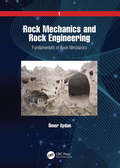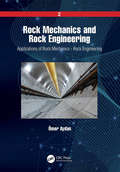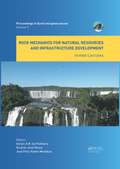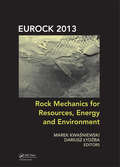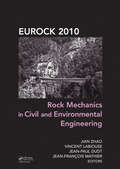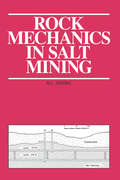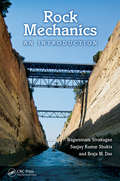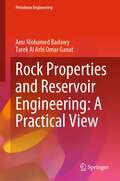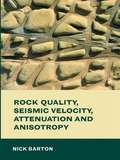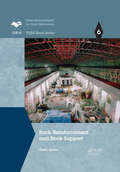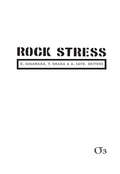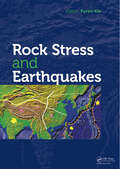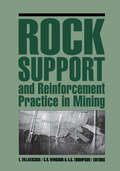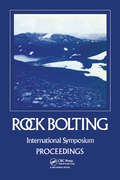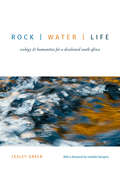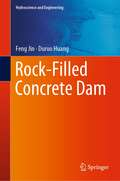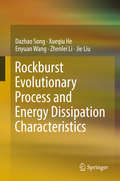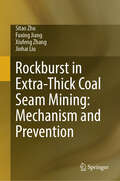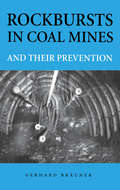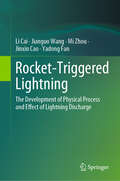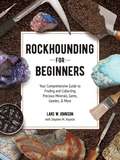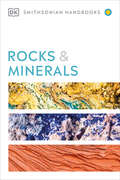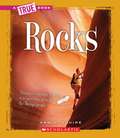- Table View
- List View
Rock Mechanics and Rock Engineering: Volume 1: Fundamentals of Rock Mechanics
by Ömer AydanThe two-volume set Rock Mechanics and Rock Engineering is concerned with the application of the principles of mechanics to physical, chemical and electro-magnetic processes in the upper-most layers of the earth and the design and construction of the rock structures associated with civil engineering and exploitation or extraction of natural resources in mining and petroleum engineering. Volume 1, Fundamentals of Rock Mechanics, discusses rock-constituting elements, discontinuities and their behavior under various physical and chemical actions in nature. The governing equations together with constitutive laws and experimental techniques and the solution techniques are explained and some examples of applications are given. A number of chapters are devoted to possible new directions in rock mechanics. Rock Mechanics and Rock Engineering is intended to be a fundamental resource for younger generations and newcomers and a reference book for experts specialized in Rock Mechanics and Rock Engineering and associated with the fields of mining, civil and petroleum engineering, engineering geology, and/or specialized in Geophysics and concerned with earthquake science and engineering.
Rock Mechanics and Rock Engineering: Volume 2: Applications of Rock Mechanics - Rock Engineering
by Ömer AydanThe two-volume set Rock Mechanics and Rock Engineering is concerned with the application of the principles of mechanics to physical, chemical and electro-magnetic processes in the upper-most layers of the earth and the design and construction of the rock structures associated with civil engineering and exploitation or extraction of natural resources in mining and petroleum engineering. Volume 2, Applications of Rock Mechanics – Rock Engineering, discusses the applications of rock mechanics to engineering structures in/on rock, rock excavation techniques and in-situ monitoring techniques, giving some specific examples. The dynamic aspects associated with the science of earthquakes and their effect on rock structures, and the characteristics of vibrations induced by machinery, blasting and impacts as well as measuring techniques are described. Furthermore, the degradation and maintenance processes in rock engineering are explained. Rock Mechanics and Rock Engineering is intended to be a fundamental resource for younger generations and newcomers and a reference book for experts specialized in Rock Mechanics and Rock Engineering and associated with the fields of mining, civil and petroleum engineering, engineering geology, and/or specialized in Geophysics and concerned with earthquake science and engineering.
Rock Mechanics for Natural Resources and Infrastructure Development - Invited Lectures: Proceedings of the 14th International Congress on Rock Mechanics and Rock Engineering (ISRM 2019), September 13-18, 2019, Foz do Iguassu, Brazil (Proceedings in Earth and Geosciences)
by Sergio A.B. da Fontoura Ricardo José Rocca José Félix Pavón MendozaRock Mechanics for Natural Resources and Infrastructure Development. Invited Lectures contains the Invited and Keynote Lectures and the prestigious ISRM Award Lectures (the Leopold Muller Award Lecture by professor Peter K. Kaiser and the Manuel Rocha Award Lecture by Dr. Quinghua Lei), as presented at the 14th ISRM International Congress (ISRM 2019, Foz do Iguaçu, Brazil, 13-19 September 2019). Starting in 1966 in Lisbon, Portugal, the International Society for Rock Mechanics and Rock Engineering (ISRM) holds its Congress every four years, where relevant themes related to rock mechanics and rock engineering are discussed. This volume covers topics ranging from fundamental research in rock mechanics, laboratory and experimental field studies, to petroleum, mining and civil engineering applications, and is a must-read for academics, engineers and students involved in rock mechanics and engineering.Proceedings in Earth and geosciences - Volume 5The ‘Proceedings in Earth and geosciences’ series contains proceedings of peer-reviewed international conferences dealing in earth and geosciences. The main topics covered by the series include: geotechnical engineering, underground construction, mining, rock mechanics, soil mechanics and hydrogeology.
Rock Mechanics for Resources, Energy and Environment
by Marek Kwaśniewski Dariusz ŁydżbaThe emphasis in Rock Mechanics for Resources, Energy and Environment is on the application of rock mechanics to the extraction of natural resources, securing energy supplies and protecting the environment surrounding rock that is subject to engineering activities. The book will be of interest to rock mechanics researchers as well as to professionals who are involved in the various branches of rock engineering.
Rock Mechanics in Civil and Environmental Engineering
by Jian Zhao Vincent Labiouse Jean-Paul Dudt Jean-François MathierDuring the last two decades rock mechanics in Europe has been undergoing some major transformation. The reduction of mining activities in Europe affects heavily on rock mechanics teaching and research at universities and institutes. At the same time, new emerging activities, notably, underground infrastructure construction, geothermal energy develo
Rock Mechanics in Salt Mining
by M.L. JeremicA study on rock mechanics in salt mining, this work includes coverage of the exploration and opening of salt mining, deformation and failure of the salt, strata mechanics and control for different mining systems, and stability analyses of the mine structures.
Rock Mechanics: An Introduction
by Braja M. Das Nagaratnam Sivakugan Sanjay Kumar ShuklaRock mechanics is a multidisciplinary subject combining geology, geophysics, and engineering and applying the principles of mechanics to study the engineering behavior of the rock mass. With wide application, a solid grasp of this topic is invaluable to anyone studying or working in civil, mining, petroleum, and geological engineering. Rock Mechani
Rock Properties and Reservoir Engineering: A Practical View (Petroleum Engineering)
by Amr Mohamed Badawy Tarek Al GanatThis book comprehensively identifies most reservoir rock properties using a very simple approach. It aids junior and senior reservoir and geology engineers to understand the main fundamentals of rock properties. The book provides examples and solutions that can help the readers to quickly understand the topic. This book covers reservoir rock properties and their relationship to each other. The book includes many figures, tables, exercises, and flow diagrams to simplify the topics in different approaches.
Rock Quality, Seismic Velocity, Attenuation and Anisotropy
by Nick BartonSeismic measurements take many forms, and appear to have a universal role in the Earth Sciences. They are the means for most easily and economically interpreting what lies beneath the visible surface. There are huge economic rewards and losses to be made when interpreting the shallow crust or subsurface more, or less accurately, as the case may be.
Rock Reinforcement and Rock Support (ISRM Book #6)
by Ömer AydanThe stability of underground and surface geotechnical structures during and after excavation is of great concern as any kind of instability may result in damage to the environment as well as time-consuming high cost repair work. The forms of instability, their mechanisms and the conditions associated with them must be understood so that correct stabilisation of the structure through rock reinforcement and/or rock support can be undertaken. Rock Reinforcement and Rock Support elucidates the reinforcement functions of rock bolts/rock anchors and support systems consisting of shotcrete, steel ribs and concrete liners and evaluates their reinforcement and supporting effects both qualitatively and quantitatively. It draws on the research activities and practices carried out by the author for more than three decades and has culminated in a most extensive up-to-date and a complete treatise on rock reinforcement and rock support.
Rock Secrets
by Betsy JamesEvery single rock has a secret story to tell about what the earth was like long ago.
Rock Stress '03: Proceedings of the Third International Symposium on Rock Stress, Kumamoto, Japan, 4-6 November 2003
by Katsuhiko Sugawara Yuzo Obara Akira SatoThis publication contains three special lectures, six keynote addresses and sixty-eight technical papers presented at the symposium. The wide variety of topics covered are grouped in the proceedings according to subject.
Rock Stress and Earthquakes
by Furen XieThe evaluation of in-situ rock stress is not only important in the exploration and engineering involving rock masses for mining, hydropower, tunneling, oil and gas production, and stone quarrying, but also in the geodynamics and earthquake prediction. The methods of determining these stresses for shallow crust in the engineering practice, including
Rock Support and Reinforcement Practice in Mining
by Ernesto Villaescusa, Christopher R.Windsor & Alan G.ThompsonThe text broadly covers recent developments in ground control techniques, and their at operating mines, worldwide. Specific topics include: design and analysis of support and re-inforcement in metalliferous mines, mesh, shotcrete and membrane support systems, and strata control in coal mines.
Rock bolting: Proceedings of the international symposium, Abisko, Sweden, 28 August-2 September 1983
by Ove StephanssonThis includes the Proceedings of the international symposium, Abisko, Sweden, 28 August-2 September 1983. Rock bolts today represent the dominant support system in mines and underground structures. Some results and experiences are discussed to give a better understanding of the strength of individual rock bolts and systems of bolts, and the interaction between bolts and rock masses of various types. Topics covered are as follows: rock bolting in theory and experiments; design principles and experience; and ground control and instrumentation: cable bolting.
Rock | Water | Life: Ecology and Humanities for a Decolonial South Africa
by Lesley GreenIn Rock | Water | Life Lesley Green examines the interwoven realities of inequality, racism, colonialism, and environmental destruction in South Africa, calling for environmental research and governance to transition to an ecopolitical approach that could address South Africa's history of racial oppression and environmental exploitation. Green analyzes conflicting accounts of nature in environmental sciences that claim neutrality amid ongoing struggles for land restitution and environmental justice. Offering in-depth studies of environmental conflict in contemporary South Africa, Green addresses the history of contested water access in Cape Town; struggles over natural gas fracking in the Karoo; debates about decolonizing science; the potential for a politics of soil in the call for land restitution; urban baboon management; and the consequences of sending sewage to urban oceans.
Rock-Filled Concrete Dam (Hydroscience and Engineering)
by Feng Jin Duruo HuangThis book provides a timely review on recent advancements in rock-filled concrete dam: a new type of dam originated from Tsinghua University in China. It covers historical overview of the development, filling process of high performance self-compacting concrete, mechanical and physical properties of rock-filled concrete, design of rock-filled concrete gravity dams and arch dams, as well as construction and quality control specifications. The book is intended for researchers, practicing engineers and graduate students who are interested in fundamental research and engineering design principles of rock-filled concrete dams. Successful insights gained from more than 120 rock-filled concrete dams completed or under construction in China are presented in this book, which can be useful references for all readers.
Rockburst Evolutionary Process and Energy Dissipation Characteristics
by Jie Liu Dazhao Song Xueqiu He Enyuan Wang Zhenlei LiThis book investigates the evolution process of rockburst based on the energy dissipation theory and proposes appropriate active prevention and control technologies. It discusses the electromagnetic radiation (EMR) generated by coal rock fractures as a measurement of the amount of dissipated energy, and the use of EMR to experimentally observe the time domain characteristics of energy dissipation during coal rock failure processes. It then proposes the concept of the rockburst activity domain system (RADS), establishes a dynamic pressure model of rockburst, and describes the energy criterion for rockburst instability. Lastly, it presents two waterjet cutting-based cases of pressure relief and rockburst prevention. The book serves as a reference resource for mine safety workers, engineering technicians, scientists, graduate students and undergraduates engaged in research on dynamic hazards such as rockburst..
Rockburst in Extra-Thick Coal Seam Mining: Mechanism and Prevention
by Sitao Zhu Fuxing Jiang Xiufeng Zhang Jinhai LiuThis book provides a detailed introduction to the mechanism of rockburst in extremely thick coal seam mining and explores the mechanical mechanism on why the critical depth of rockburst in extremely thick coal seam mining is significantly smaller than that in thin to thick coal seams, it also proposes targeted monitoring, warning, and treatment technologies. The prevention and control of coal mine rockburst is a global problem, attracting engineers and scientists from various disciplines such as mining, geology, geophysics, and civil engineering to conduct research. This book provides multiple case studies of rockburst accidents in mining of ultra-thick coal seams and provides a detailed analysis of the mechanisms and treatment technologies of each rockburst accident. It aims at graduate students, researchers, and on-site engineers who are interested in the mechanism of rockburst occurrence, monitoring, early warning, and treatment technology. The translation was done with the help of artificial intelligence. The present version has been revised technically and linguistically by the authors in collaboration with a professional translator.
Rockbursts in Coal Mines and Their Prevention
by Gerhard BraeunerThe preventive methods described have proved highly effective. They comprise laying out the workings in such a way as to minimize dangerous concentrations of ground stresses, and early elimination by means of blasting, drilling, or water infusion. An account of these methods as applied in German coal mines, the deepest in the world. Contents: Rockbursts & similar phenomena; Conditions of occurrence; Influence of rock stress; Bursting & nonbursting coal; Long-term prevention; Direct prevention; Borehole patterns for direct prevention; Destressing methods; Case histories.
Rocket-Triggered Lightning: The Development of Physical Process and Effect of Lightning Discharge
by Mi Zhou Jianguo Wang Li Cai Jinxin Cao Yadong FanThis book summarises the fruitful results of rocket-triggered lightning experiments conducted in Guangdong, China, in recent years, including data analysis and theoretical research. One of the main features of this book is to compare the differences between lightning strikes on overhead power lines and strikes on the ground. Starting from the technical background and experimental methods of rocket-triggered lightning, the book delves into the electric current, electric field, magnetic field, optical and acoustic characteristics of artificially triggered lightning. Proceeding progressively from basic to advanced levels, this book meets the needs of scientists at different levels of expertise. It will benefit researchers, engineers and graduate students working in the fields of lightning detection, lightning physics and lightning protection.
Rockhounding for Beginners: Your Comprehensive Guide to Finding and Collecting Precious Minerals, Gems, Geodes, & More
by Lars W. Johnson Stephen M. VoynickGo on an outdoor treasure hunt and enjoy all nature has to offer with this field guide to rockhounding, perfect for armchair geologists or anyone headed out on an adventure!Geology meets treasure hunting with this field guide to rockhounding! If you&’ve ever kept an interesting rock or shell, bought a polished stone from a gift shop, or even just enjoyed a &’gram of a really cool crystal, congratulations! You&’ve already experienced a rockhounding adventure! Rockhouding for Beginners shows you how to take your rockhounding to the next level, providing everything you need to know from tips for finding local sources for really cool finds to techniques for safely cleaning, cutting, polishing, and caring for the best samples. Complete with full-color photos to help you identify each rock and mineral wherever you find them, this guide has all the rockhounding information you need whether you&’re ready to get down and dirty or simply want to learn more from the comfort of your couch.
Rocks & Minerals
by Seymour SimonAward-winning science writer Seymour Simon explains to readers the different types of rocks and minerals with fascinating facts and stunning full-color photographs. This nonfiction picture book is an excellent choice to share during homeschooling, in particular for children ages 6 to 8. It’s a fun way to learn to read and as a supplement for activity books for children.Readers will learn how to identify and classify various kinds of stones, such as granite, sandstone, basalt, quartz, and crystal.This book includes an author's note, a glossary, and an index and supports the Common Core State Standards.
Rocks & Minerals (DK Handbooks #137)
by Chris PellantUnearth a treasure trove of knowledge and discover the spectacular array of rocks and minerals on Earth! Learn how to identify more than 500 rocks and minerals of the world through stunning photographs, detailed characteristics, and quick, accessible text.Inside the pages of this comprehensive book about rocks and minerals, you&’ll discover: • A clear visual key distinguishing different rocks and minerals to make identification easy and accurate • Entries that include at-a-glance technical details, for quick reference • Stunning photographs that show close-ups of key details and unique attributes • Highlights of the key features of minerals: chemical group and composition, hardness, specific gravity, crystal cleavage, and fracture • Highlights of the key features of rocks: group, origin, pressure and temperature, grain size and shape, classification, and fossils All you ever wanted to know about rocks and minerals - and then someFrom igneous, metamorphic, and sedimentary rocks to sparkling minerals, SI Handbooks: Rocks & Minerals leaves no stone unturned. Over 600 high-quality photographs highlight over 500 rock or mineral's distinguishing features. Explore concise details about each rock or mineral's texture, origin, formation, and chemical composition to help you with accurate identification.Discover a mine of information at your disposal! Designed for beginners and experienced collectors alike, this mineralogy book explains what rocks and minerals are, how they are classified, and what equipment is needed for specimen collection. It&’s the ultimate gift for rock collectors - both beginners and enthusiasts, or anyone studying geology and earth sciences. Don&’t stop exploring! Before you go, there are many more SI Handbooks to explore! Discover the cleanest-cut photographic field guide to over 130 gemstones from around the world in SI Handbooks: Gemstones. Learn all about dinosaurs and prehistoric animals and the world they inhabited millions of years ago in SI Handbooks: Dinosaurs.
Rocks (A True Book™)
by Ann O. SquireJust what is hiding in the ground beneath you feet? Get ready to explore the fundamentals of earth science! The fascinating facts and fun activities in these informative titles help you learn all there is to know about fossils, gemstones, rocks, and minerals.
